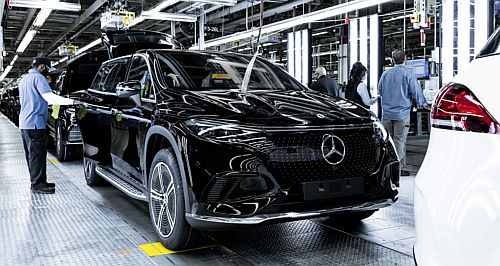Cooling demand prompts EV rethink

SLOWING demand for electric vehicles, particularly in the North American market, has forced several automotive manufacturers to recalibrate their future plans.
Latest on this list are German luxury trio Audi, BMW, and Mercedes-Benz, who say they will continue to invest in internal combustion engine development, even as they plan for an electric future.
Mercedes-Benz said previously it will go all-electric by 2033 where market conditions allowed. But with slow EV sales across the board, the brand now plans to develop internal combustion and electric-powered cars in parallel for longer than initially expected.
“The speed of transformation – it is almost impossible to foresee how long it will take,” Mercedes-Benz chief executive officer Ola Kallenius told Automotive News. “We are well positioned to play the flexibility card into the 2030s.”
Conversely, rival BMW’s long-term strategy of spreading its investments across ICE, HEV, BEV, and even Hydrogen FCEV has proven prescient. BMW will update key petrol-powered SUVs over the next few years while it pushes ahead on the electric front.
“We want to make sure that we can cater to all these customer groups,” said BMW North America chief executive Sebastian Mackensen. “We think that approach to staying flexible and having one car with different powertrains is a very good one.”
BMW expects EVs to account for half its global sales by the end of this decade. To help it get there, it will initially launch six battery-powered models based on the all-electric Neue Klasse platform, including electric variants of the X3 and X5 SUV.
Audi meanwhile is still pursuing an all-electric portfolio by 2033. The brand’s Premium Platform Electric architecture will underpin two new models in the near-term, including the Q6 e-tron SUV and A6 e-tron Sportback.
But it is not just OEMs that are feeling the pinch of waning demand. EV part suppliers say they have adjusted their financial outlooks, producing fewer components than anticipated as the market settles.
“The market has shifted drastically,” said Magna International chief executive officer Swamy Kotagiri, noting lower-than-expected sales, delayed EV product rollouts, cuts in production targets and a shift toward smaller, more affordable electric models.
Mr Kotagiri’s comments come as the supplier disclosed its second-quarter results this week, lowering its outlook through to 2026. It now expected about 10 per cent less revenue than previously forecast, an indicator for how quickly the EV landscape is changing.
While larger Tier 1 supplies should be able to manage such a significant shift in demand, it is feared smaller companies in lower tiers are at risk.
“Those companies invest in the near term, and if that near-term plan included electric vehicles and its doesn’t anymore, that could be very costly for these small companies – and could potentially put them at risk of going out of business,” AutoForecast Solutions vice president of global vehicle forecasting Sam Fiorani told Automotive News.
Magna International said it expects around $US2 billion ($A3.02b) less revenue in 2026 from EV part sales than originally expected; a figure that includes as much as $US900 million ($A1.4b) in additional combustion engine related business.
Other suppliers, including BorgWarner, say they will cut employee numbers and spending across e-product divisions.
BorgWarner says it has reduced its full-year sales outlook by $US400 million ($A604m) due to lower production and slowing demand for battery electric vehicles.
“A lot of our combustion products go into hybrids and are a key element of making the combustion side of hybrid lean and efficient,” said BorgWarner chief executive officer Fred Lissalde. “When you think about BorgWarner, I don’t think you should try and split combustion, hybrid, and BEV.”
Similarly, LearCorp, pinned its guidance cut in part on slower EV sales growth and changes to EV demand. It reported modest gains in second-quarter income, but has wound back its full-year net income forecast by as much as $US210 million ($A317m).
“Our adjustment to the second-half outlook is greater than we had anticipated,” said LearCorp chief financial officer Jason Cardew. “That really reflects the ramp-up in announcements, and also our extrapolation of what that may mean into the fourth quarter, particularly on electric vehicle platforms.”
With Automotive News